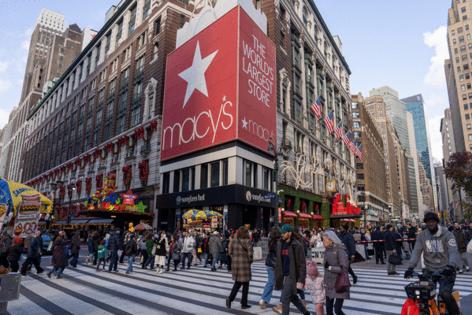Anxious retailers look to deals, doorbusters to revive sales
Published in Business News
The lure of $10 gift cards wasn’t enough to draw big early-bird Black Friday crowds at the Macy’s Inc. flagship New York City location in Herald Square.
Andre Langer, 26, and Nicole Galler, 25, were visiting from Germany and arrived at Macy’s when it opened at 6 a.m., hoping to see people storm through the entrance. There were fewer shoppers than they expected, though, and they weren’t impressed with the deals. “They’re not that good,” Langer said.
Macy’s and other retailers that cater to middle-income consumers went into the holiday shopping season hoping that exclusive products and special promotions could help revive demand in an otherwise humdrum year.
Their efforts spoke to the high stakes that many retailers are facing after a year of sluggish sales. Some are kicking off the biggest shopping holiday with new chief executives, raising the bar even higher to generate stronger sales. To add to challenges, the shopping season is five days shorter this year than it was in 2023 due to a late Thanksgiving.
For the most part, their efforts didn’t appear to be enough to draw early crowds. A Best Buy in Mount Vernon, New York, was nearly empty a little before 8 a.m., with traffic much slower than expected, according to a security guard stationed there.
Soft expectations
U.S. retailers garner about 20% of their annual sales during the holiday season, and early projections have pointed to this year being softer than those past.
Online and in-person U.S. holiday sales are expected to rise between 2.5% and 3.5% this year, according to the National Retail Federation, an industry group. That’s behind last year’s growth of 3.9%. Those figures reflect sales for November and December and aren’t adjusted for inflation.
Some of the slowdown may stem from early gift buying that’s not captured in holiday sales data. Various sales events in October — such as Amazon.com Inc.’s Prime Day — likely pulled forward shopping demand, according to Coresight Research, affecting traditional holiday sales days like Black Friday. About 52% of consumers began holiday shopping before November, higher than last year.
U.S. online sales rose 5% year-over-year to $9.6 billion on Black Friday as of 4 p.m. New York time, according to Salesforce. Growth is slower than last year, when U.S. online sales increased 9% to $9.4 billion during the same period.
For the first half of Black Friday, average discount rates slightly decreased to 27% from 28% last year, according to Salesforce. The numbers don’t capture the entire day and aren’t final.
At the King of Prussia mall in Pennsylvania on Friday morning, business owner Carla Schiavo said she hadn’t seen many good deals. “I got better deals the last two weeks online,” Schiavo, 49, said.
At Walmart, many shoppers have been buying Black Friday deals online since last Monday, according to chief merchandising officer Latriece Watkins. Apple AirPods, 65-inch Roku TVs and men’s denim were among the bestsellers in stores on Black Friday.
Turnaround hopes
While all retailers look to the holidays for a boost, those that cater to middle-income shoppers are feeling particularly pinched by a slowdown in discretionary spending.
Under Macy’s Chief Executive Officer Tony Spring, who took over in February, the largest department store in the U.S. by revenue and number of stores is trying to draw more shoppers.
Macy’s discounts this year were roughly in line with last year, including 40% to 50% off some boots and shoes and 50% off select handbags and wallets, but it’s betting newer products from different brands will attract shoppers. Traffic at the Herald Square Macy’s picked up as the day continued.
Target, which cut its annual forecast last week citing slowing demand for discretionary products, saw an early rush of shoppers who came to buy Taylor Swift’s "The Eras Tour Book," which the company said is already its bestselling title of the year.
The company said sales of all three exclusive Swift products – the book, vinyl and CD – have exceeded expectations so far. Items were exclusively sold in stores Friday and will be available online starting Saturday.
At 8:45 a.m., Sasha Drozdetski of Ardsley, New York, was already on her second Target trip of the day, wearing a full Swift-themed sweat suit.
Drozdetski, 34, had first arrived at the White Plains, New York, store at 5:30 a.m., she said. By 5:58 a.m. she and about 50 other Swifties were let in to buy the items. In line, she said, “we were trading friendship bracelets.”
Home Depot Inc., which has seen a pullback in demand for big-ticket home improvement purchases in recent years, said traffic and demand on Black Friday were meeting expectations, thanks to favorable, dry weather in most areas of the country and an expanded assortment of in-store doorbusters.
In-person slowdown
The pace of shoppers visiting stores in person was expected to slow somewhat this Black Friday versus last year, according to Grant Gustafson, head of retail consulting and analytics at Sensormatic Solutions, a retail technology provider. Shoppers are tired of price increases since the pandemic and are prioritizing spending on essentials, he said.
Last year, in-person store visits rose 5.2% on Black Friday versus the prior year. “It may be a stretch to expect the same level of year-over-year growth we saw last year,” Gustafson said. Overall foot traffic is likely to be flat to slightly down during November and December compared with 2023, Gustafson says.
At a Macy’s in Bethesda, Maryland, workers were still giving out $10 gift cards two-and-a-half hours after opening. The promotion was supposed to just be for the first 100 customers, but an employee said they decided to hand out more.
———
(With assistance from Lily Meier, Deena Shanker, Julia Fanzeres, Michelle Fay Cortez and Allyson Versprille.)
©2024 Bloomberg L.P. Visit bloomberg.com. Distributed by Tribune Content Agency, LLC.












Comments